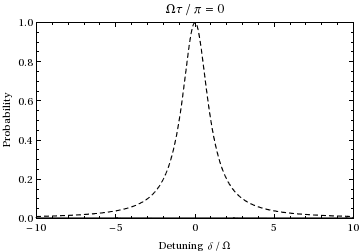Rabi frequency
The Rabi frequency is the radian frequency of the Rabi cycle undergone for a given atomic transition in a given light field. This is thus the frequency of fluctuations in the populations of the two atomic levels involved in that atomic transition in that situation. It is proportional to the strength of the coupling between the light and the atomic transition and to the amplitude (not intensity) of the light's electric field. Rabi flopping between the levels of a 2-level system illuminated with light exactly resonant with the transition will occur at the Rabi frequency; when the incident light is detuned from resonance then this occurs at the generalized Rabi frequency. The Rabi frequency is a semiclassical concept as it is based on a quantum atomic transition and a classical light field.
In the context of a nuclear magnetic resonance experiment, the Rabi frequency is the nutation frequency of a sample's net nuclear magnetization vector about a radiofrequency field. (Note that this is distinct from the Larmor frequency, which characterizes the precession of a transverse nuclear magnetization about a static magnetic field.)
Definition
The Rabi frequency is defined as
where is the transition dipole moment for the transition and is the vector electric field amplitude which includes the polarization. The numerator has dimensions of energy, so dividing by gives an angular frequency.
By analogy with a classical dipole, it is clear that an atom with a large dipole moment will be more susceptible to perturbation by an electric field. The dot product includes a factor of , where is the angle between the polarization of the light and the transition dipole moment. When they are parallel the interaction is strongest, when they are perpendicular there is no interaction at all.
In real systems, with more than two levels, the correct dipole transition matrix element for the relevant transition has to be calculated. When equating the Rabi frequency the correct Clebsch–Gordan coefficient has to be considered.

Generalized Rabi frequency
For an incident light field that is not exactly at the resonant frequency of the transition, one may refer to the generalized Rabi frequency . Rabi flopping actually occurs at the generalized Rabi frequency in that situation.
where is the detuning, a measure of how far the light is off resonance relative to the transition. For instance, examining the above animation at an offset frequency of ±1.73, one can see that during the 1/2 Rabi cycle (at resonance) shown during the animation, the oscillation instead undergoes one full cycle, thus at twice the (normal) Rabi frequency , just as predicted by this equation. Also note that as the incident light frequency shifts further from the transition frequency, the amplitude of the Rabi oscillation decreases, as is illustrated by the dashed envelope in the above plot.